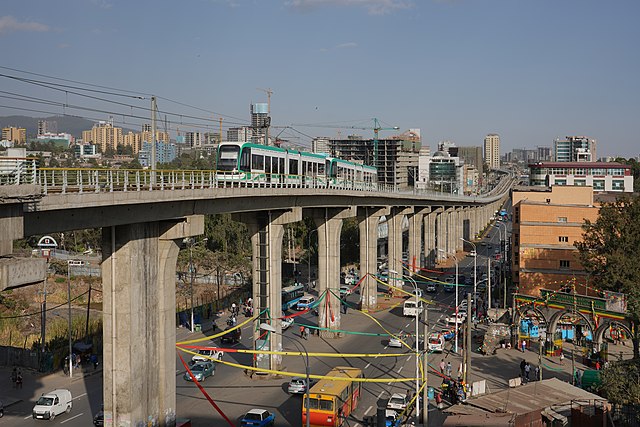Addis Ababa, the capital of Ethiopia, has a 19.6-mile light-rail system that consists of a north-south line intersecting an east-west line. It cost $475 million, or less than $25 million per mile. That sounds like a good deal compared with U.S. lines now under construction or in planning, the least expensive of which is more than $135 million a mile and the average cost is more than $275 million a mile.
Addis Ababa’s light-rail line. Photo by A.Savin.
There’s just one little problem. Although the light-rail system is just seven years old, it is already suffering serious maintenance problems. Only eight of the city’s 41 light-rail trains are functional, and the city has resorted to operating just every other day in order to do track maintenance. The city estimates it needs $60 million to restore the system to full capacity, which it doesn’t have.
The light-rail line was built by the China State Railways with loans from the Export-Import Bank of China. The rail cars were manufactured in China. Addis Ababa owes China $13 billion for assorted projects, and the bank is reluctant to loan it more money to maintain the rail system as the city, it fears, doesn’t have the capacity to repay the loans it already has. Suddenly, $25 million a mile doesn’t sound like such a great bargain after all.
Alemayehu Geda, an economist at Addis Ababa University, says the light-rail line “was a poorly planned and executed project that went ahead for purely political reasons and was destined to fail.” But Eric Olander, of the China Global South Project, argues that growing African cities like Addis Ababa need light rail because its “ever more important to be able to move people around quickly and efficiently.”
The problem with that is that if you want move people around quickly and efficiently, light rail is not the way to do it. As Antiplanner readers know, light rail is high-cost, low-capacity transit because, even at $25 million per mile, it costs more than buses and can’t carry as many people per hour as buses in a dedicated bus lane or even a shared high-occupancy vehicle lane.
Currently, Addis Ababa is served by a public bus system, at least two private bus systems, and an Uber-like taxi system. Collectively, these forms of transit carry well over 2 million trips per day (compared with about 150,000 on the light rail). The private buses, however, suffer from overregulation. Residents complain that the light-rail system didn’t fix the region’s transport problems and actually made them worse by crowding out buses and taxis.
In short, Addis Ababa is a classic case of rail proponents overpromising the benefits and underestimating the costs of light rail. In this case, the strategic misrepresentations were made by the Chinese state-owned companies while here in the U.S. they are made by consulting firms such as HDR.
Speaking of consulting firms, a recent report from New York University’s Marron Institute found that New York has spent almost twice as much on consultants for its Second Avenue Subway than it spent actually building the subway. These consultants end up being the primary political backers for rail projects. Consultants have previously been identified by the Hawaii state auditor as the primary reason why Honolulu’s rail costs have gone out of control.
It may be that some foreign countries could use a few more consultants. Spain has ruefully announced that it spent almost $280 million on new trains that are too big to fit into its railroad tunnels. At least two rail managers have been fired over the incident, but as one commenter points out, a purchase of that size “must have passed through many offices [and] numerous meetings must have been held.” It doesn’t seem like it would take an expensive consultant to say, “Don’t buy trains too big to fit on your tracks.”
I spent the first half of my career helping environmental groups fight government subsidies to large corporations that would harm the environment and spent the second half fighting environmental groups who supported giving subsidies to large corporations that would harm the environment. Anyone who actively supports building new rail transit lines in the United States is really just a tool of consultants and other corporations who are trying to get as much money as possible out of taxpayers for projects that provide few to no transportation benefits. It appears this rule of thumb extends to developing countries such as Ethiopia as well.









China will end up owning Africa the west too woke to care.
It’s not get what you pay for.
You get what you voted for.
Vote sheep, get fleeced.
China’s debt amassing empire is blanket tonassess and handle distraction from its own debts. Evergrande collapse economic nightmare. When it defaults with other Chinese developers it’ll be a reality horror.
You can replace Addis Ababa, Ethiopia with Ottawa, Canada and get the same writeup, a disastrous LRT project which is still under construction. Ottawa, however, is the capital city of a G7 country and its LRT trains are made in Europe (with no Chinese money).